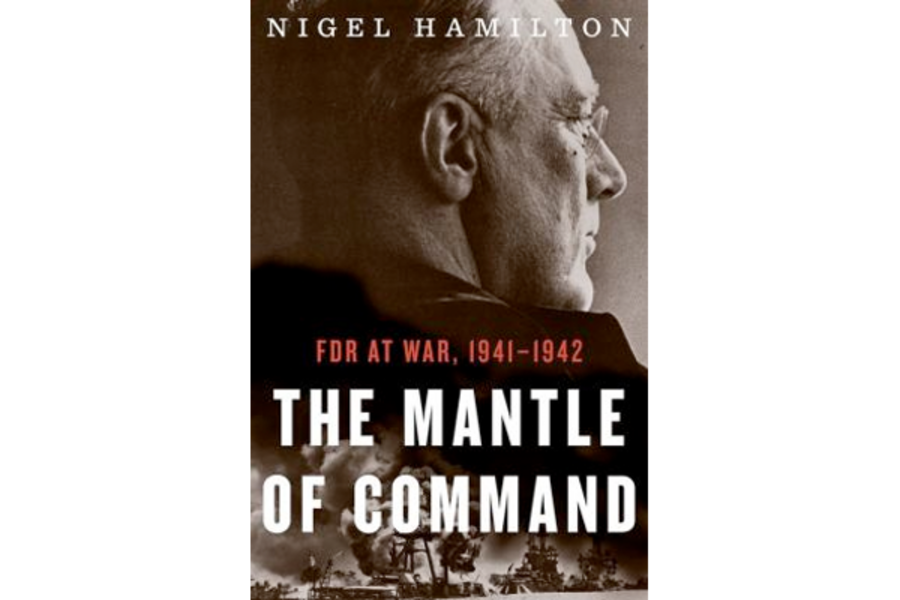"Mantle of Command" examines FDR's role as commander in chief
Loading...
Franklin Roosevelt’s position as one of America’s greatest presidents is well-established and the number of books written about his life and career would easily fill a small library. But one central aspect of his presidency – his role as a military leader during World War II – has been relatively unexamined. The military strategies pursued by Churchill, Stalin and the key generals – Marshall, Eisenhower, and Montgomery – have been exhaustively dissected. But Roosevelt’s role as commander in chief has not been studied in detail.
American historian Nigel Hamilton addresses this important issue in a valuable but somewhat disappointing new book, The Mantle of Command: FDR at War 1941-1942. Most biographers and historians who have examined this topic portray Roosevelt as relying heavily on his very able military team to manage the war effort. But Hamilton concludes that Roosevelt was far more deeply involved in day-to-day military decisions than previously believed. Moreover, he often overruled his civilian and military advisers or insisted on pursuing his preferred course of action even as they, on occasion, actively sought to undermine him. In short, Hamilton finds a very different military leader than we are accustomed to. Think of him as “FDR: The Warlord.”
Hamilton wants to recreate “the drama, the issues and the confrontations Roosevelt faced as well as the historic decisions he had to make as commander in chief...” The perspective is “unabashedly that of Franklin D. Roosevelt” and he concludes that “had FDR …not learned to wear the mantle of command so firmly, and to overrule his generals, it is quite possible that Hitler would have achieved his aim …. winning the war in Europe. It is a sobering reflection.”
This book is organized around a number of key events and decisions that occurred between August 1941 and late 1942: the summit with Churchill at Placentia Bay, Newfoundland; Pearl Harbor; McArthur’s defeat in the Philippines; the fall of Singapore and the collapse of the British in the Southeast Pacific; the British defeat at Tobruk; Jimmy Doolittle’s raid on Tokyo; the stunning American victory at Midway; and the Allied invasion of North Africa. A subsequent book will examine the remainder of the war.
As the central illustration of Roosevelt’s decisive leadership in the “business of war” during this period, Hamilton analyzes “Operation Torch,” the allied invasion of North Africa in November 1942. The core issue facing the Allies was where and how to strike Nazi Germany. America’s military leaders, especially George Marshall and Secretary of War Henry Stimson (along with Joseph Stalin), championed an invasion of Western Europe at the earliest possible time. The British thought such a step was premature. Roosevelt wanted to attack the Germans but knew the Allies were not ready to invade France and feared such a step would prove disastrous.
So he proposed to attack Northwest Africa. His reasoning was that opposition to the landing would likely be minimal, since the area was controlled by the Vichy French, and it would provide a good chance to try an amphibious operation before attacking more strongly defended territory. Roosevelt consistently and steadfastly championed this idea and, eventually, won over the British and bludgeoned the American military command until it went along. The invasion went smoothly and Roosevelt’s vision and leadership were vindicated.
In describing Roosevelt’s extensive engagement with the Allied war effort, Hamilton shows some of the leading figures in a very different light than we usually see them, including Winston Churchill, George Marshall, and Secretary of War Henry Simpson. The portrait of Marshall is especially unflattering and may lead to a reexamination of his role and reputation.
This is revisionist history in the best sense of the word – it forces us to rethink assumptions and to reconsider the way that history unfolded and the role that leading individuals played. This bold argument is extensively researched, well-stated, and will undoubtedly change the way we see Franklin Roosevelt.
Unfortunately, the book is somewhat undermined by errors (the Lusitania was not a “neutral American liner”), a tendency toward overstatement (Stimson and Marshall’s opposition to Operation Torch was not a “mutiny” nor does building a ten-thousand-ton freighter in ten days qualify as “an almost biblical achievement”), repetition (we are told three times in five pages that General McArthur’s Air Force planes were destroyed on the ground when Japan attacked the Philippines), and an occasionally breathless prose that features an excessive use of exclamation points.
And not all his assertions ring true. For example, he writes, “As commander in chief, the challenge for Roosevelt was thus how to marshal Marshall: how to direct, encourage and support his work at the war department, while stopping him from losing the war for America.” Presumably if Roosevelt thought that “losing the war for America” was even remotely possible, he would have quickly relieved Marshall, especially given Hamilton’s central thesis that Roosevelt was a hands-on, decisive military leader. In another case, he implies that Roosevelt’s personal commitment to General Jimmy Doolittle’s April 1942 bombing of Tokyo led the Japanese to try to seize Midway Island – in fact, Japanese planning for Midway was underway before the surprise attack on the Japanese homeland.
The shortcomings are disappointing because Hamilton’s thesis is compelling and worth careful consideration. One hopes that the second volume of his study, which will cover the remainder of the war, will be more careful and measured. The argument and evidence are too important and valuable to be undermined by the limitations found in the first volume.
Terry Hartle is a Monitor contributor.






